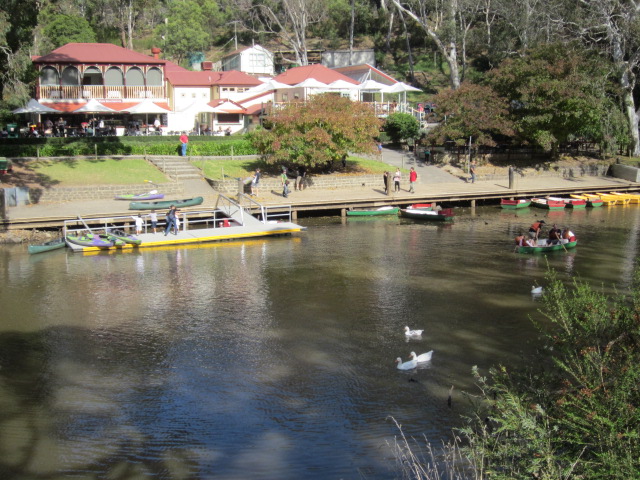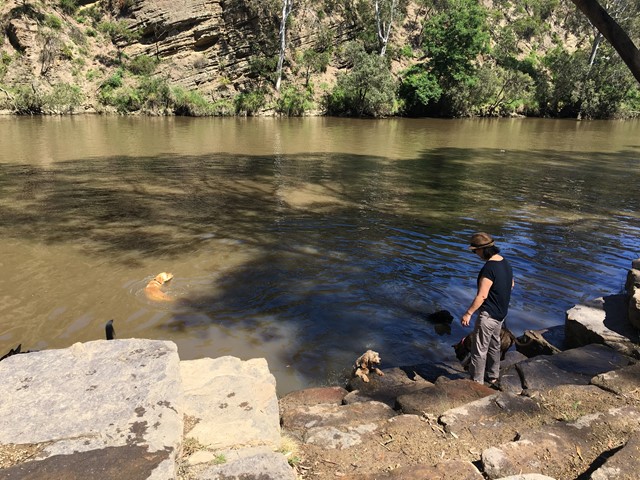Yarra Bend Park (Kew)


At Yarra Bend Park, the largest area of natural vegetation near the City of Melbourne, the landscape varies from steep, wild river escarpments to open woodlands, formal parkland, playing fields and golf courses. It has over 16 km of river frontage, and superb views of the city and the Dandenongs from the higher areas.
Things to Do
- The park is used for boating, canoeing, team sports, golf, fishing, orienteering, picnicking, dining out, bird watching and just enjoying the bush.
- A shared walking and bicycle path follows the Yarra and high above the Merri Creek in the western and northern parts of the park.'
- Practise your casting at the international fly-casting pool
- Open space and sporting fields are used for organised and informal sports including cricket, football, soccer and bocce.
- There are many walking tracks at Yarra Bend Park to suit all fitness levels. The popular Main Yarra Trail passes through the park extending from Templestowe to Southbank. Secluded riverside trails follow the Yarra through peaceful bush surrounds. Varying length circuit trails take you to popular sites including Dights Falls and Deep Rock.
- 18 hole golf course and 9 hole par 3 golf course.
Facilities
- Studley Park Boathouse, built in 1863 and recently restored, offers cafe, bistro and restaurant dining and canoe and rowboat hire.
- Picnic areas
- Kanes Bridge leads across the river to picnic areas, sports grounds and the 18 hole Yarra Bend Golf Course.
- The nine hole Studley Park Par 3 Golf Course is situated on Walmer Street, Kew.
- Studley Park Picnic Area (close by Studley Park Boathouse) offers picnic shelters, electric barbecues and toilet facilities.
- Bellbird Picnic Area (off Yarra Boulevard) offers a peaceful alternative to busy Studley Park. This setting provides a shelter, electric barbecue, toilet facilities and canoe-launching ramp.
Heritage
The junction of the Merri Creek and Yarra River on the western side of the park was an important meeting site for the Wurrundjeri people, with good hunting and fishing.
When Europeans arrived, the natural beauty of the area was soon recognised and a location in the south of the park was considered as a site for the first Government House. This area and surrounds were reserved as parkland in 1877.
At Dight's Falls, a weir was built on a natural rock bar in the early 1840s to supply water to the Dight brothers' flour mill - the old bluestone water channel and ruins of the mill can still be found on the north bank.
A number of institutions were established in the park throughout the nineteenth century, the most significant being the Yarra Bend Lunatic Asylum established at the end of Yarra Bend Road in 1848. The Asylum was closed in 1925, the only remnants being mature Elms and Moreton Bay fig trees, and a bluestone pillar.
Fauna
A total of 185 indigenous native fauna species have been recorded within Yarra Bend Park, including 125 bird, 10 mammal, 19 reptile, 15 butterfly, 5 amphibian and 11 freshwater fish. The Park contains 13 of Victorian's 178 threatened fauna species including seven endangered and four vulnerable species. Birds commonly seen in Yarra Bend Park include the Rainbow Lorikeet, Red-rumped Parrot and on occasions, theYellow-tailed Black Cockatoo. Mammals found in the park include Echidnas, native Water Rats and Brush-tail and Ringtail Possums.
Grey-headed Flying-foxes at Yarra Bend Park
Grey-headed Flying-foxes are an important part of Melbourne's wildlife, and until recently have been roosting in the Royal Botanic Gardens. Their presence in the Royal Botanic Gardens was not sustainable due to the sensitive nature of the vegetation.
A relocation project was undertaken and the colony was successfully moved out of the Royal Botanic Gardens. In October 2003, the colony moved to Yarra Bend Park, where the females gave birth and raised their young over the summer months. Recently the State Government announced that Yarra Bend Park would remain the permanent roost site for Melbourne's colony of Grey-headed Flying-foxes. The flying-fox colony is best viewed from Yarra Boulevard or Bellbird Picnic Area. Check out more information about Melbourne's flying-foxes.
Vegetation
Yarra Bend Park contains some of the last stands of original bushland in inner Melbourne, with approximately half of the park covered by indigenous vegetation. The Park supports a high diversity of indigenous plants (approximately 292) and is defined by two broad vegetation groups, these being Plains Grassy Woodland and Valley Grassy Forest. Yarra Bend Park contains 7 of the state's threatened flora species, one endangered, three vulnerable and three species suspected of being endangered, vulnerable or rare. In addition, 117 flora species are recognised as being important in the Melbourne Region.
Looking After the Park
- No dogs or bicycles in bushland conservation areas.
- Yarra Bend Park has a 'Carry In - Carry Out' rubbish policy. Please take all rubbish with you when you leave.
- Abide by the On and Off Lead Dog Zones shown on the park map.
- Solid fuel barbecues or ovens (those that use wood, charcoal or briquettes) are not permitted at Yarra Bend Park.
- On days of Total Fire Ban, use only electric barbeques provided.
- Car parking is permitted only in marked spaces. No vehicles to be parked on ovals or open grass areas.
- Remember that all native plants and animals are protected.
Precautions
- Care should be taken while walking on trails in bush areas near escarpments.
- Snakes are active during the warmer months at Yarra Bend Park.
How to Get There
The park can be accessed by car or bus via Studley Park Road and Yarra Boulevard, Kew, or Yarra Bend Road, off Heidelberg Road, Fairfield.
Review:
There are a range of activities centred around the Studley Park Boathouse but also a decent 4km return walk following the Yarra River from Kane's Bridge all the way to Dights Falls (which has now been replaced by a new fishway). There are enough interesting elements along the walk to keep the kids involved.
Be on the alert for the following places:
The Yarra Aboriginal Protectorate Station - In the 1840s a government station was established by William Thomas, Assistant Protector of Aborigines for the Melbourne region. From a small hut Thomas, distributed rations, and conducted school classes and religious services for the Wurundjeri people and other visiting Aboriginal groups.
The Native Police Corps, comprising Aboriginal people under the leadership of Captain Dana, also used the area for their temporary headquarters between 1842 and 1843.
Drawing on the strengths of a rich culture, Aboriginal people survived the devastating effects Of European settlement. Today the Wurundjeri Tribe Land Compensation and Cultural Heritage Council Incorporated are the Aboriginal custodians of the area.
Deep Rock Swimming & Life Saving Club was established at the site in 1906 operated until the 1940s.
In the 1920s the Yarra was enjoying a peak of popularity. Many inner Melbourne residents used this location for recreational swimming, competitions and training. In 1918 a crowd of more than 70,000 watched as Mick Wickham made a successful world record dive of 62.7m from a tower on the cliff.

This area has an embankment of flat boulders to provide access to the river from the river bank. These stone steps are used by lots of dogs to go for a dip in the river. This area is also for swimming by some people as well as dogs. However, the quality of the water can often be poor, especially after rain and there is plenty of sediment in the water which means zero visibility.
Dights Falls area has significant cultural importance to the Wurundjeri people. It is an intertribal meeting place and the likely burial place of their ancestor Billibellary, Chief of the Yarra Yarra Tribe. Wurundjeri people still visit Dights Falls for traditional meetings and activities.
Geology - The cliffs on the opposite bank to Dights Falls show sedimentary layers of sandstone and mudstone which have been dated using marine fossils found to be 420 million to 445 million years old. The course of the Yarra River was pushed up against these older outcrops by lava flows which poured down the Merri and Darebin Creek valleys from northern and western Victoria 780,000 to 1 million years ago.
History of the Weir - The old weir at Dights Falls dated back to 1895 when a timber weir was built to provide water to the Melbourne Flour Milling Company. The timber weir was replaced with a new concrete weir in 2012 and a fishway was installed to increase native fish populations. Today, the weir sets the minimum water level of the Yarra River for about 16km upstream, supporting the historic Fairfield and Studley Park boathouses and activities such as canoeing, kayaking and fishing.
Helping native fish to breed - The Yarra River supports 17 species of native freshwater fish, including 11 that need to migrate between saltwater and freshwater environments as part of their lifecycles. In the past, Dights Falls has been a significant barrier to this migration. The fishway at Dights Falls was built in 2012 to help fish make their way upstream to feed and breed. It is expected to benefit up to 2,000 kilometres of the Yarra and its upstream tributaries, boosting native migratory fish numbers, including endangered species, such as the Australian Grayling.
Yarra Bend Asylum was located here as the Yarra River almost surrounded the area, providing excellent security. The asylum operated here between 1848 and 1925. At times over 1000 inmates were housed here and the asylum was almost a self-sufficient township. Unfortunately conditions were poor and residents suffered severe hardship. The asylum was decommissioned and demolished in 1925, and only fragments now remain; bluestones that marked borders of vegetable gardens, and the pillar from the main gate.
Photos:
Location
Yarra Boulevard, Kew 3101 View Map
Web Links
→ Yarra Bend Park(Parks Victoria)
→ Yarra Bend Park - Visitor Guide (PDF)
→ Studley Park Boathouse Website
→ Studley Park Boathouse on Facebook
→ Yarra Bend Park Walking Track (PDF)
→ Yarra Bend Park Aboriginal History (PDF)
→ Yarra Bend Park Geology (PDF)
→ Yarra Bend Park History (PDF)
→ Yarra Bend Park - Park Note (PDF)
→ Yarra Bend Park Dog Friendly Park - Park Note (PDF)
→ Yarra River Boating Guide - Park Note (PDF)









